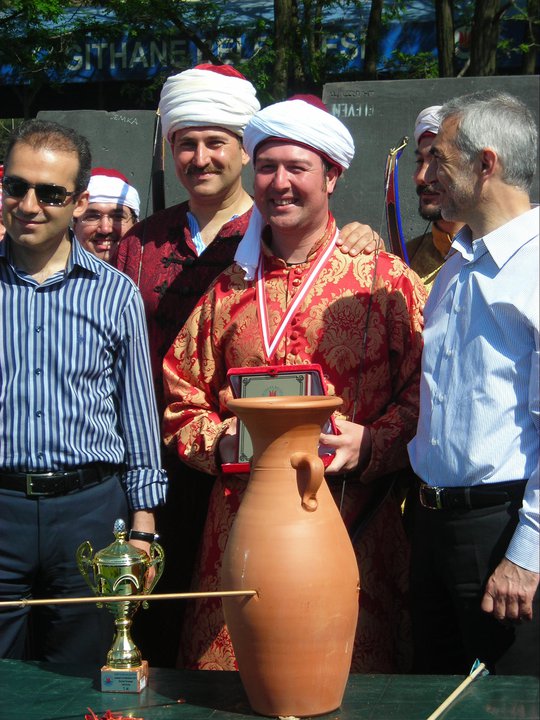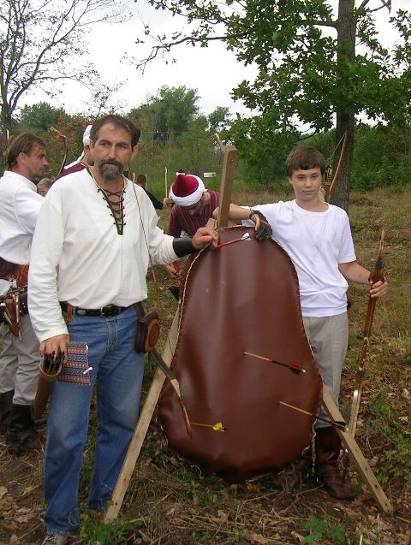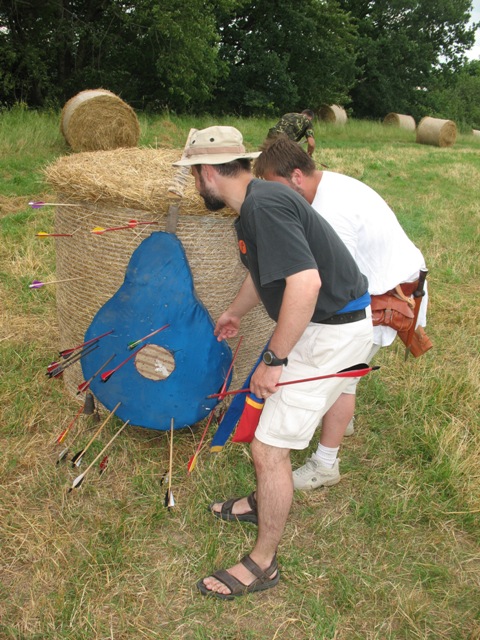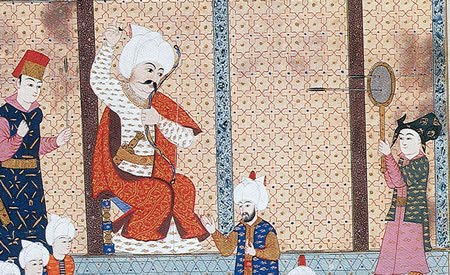 Overview of Puta ShootingAkın Öğretici Throughout the history of mankind, archery has emerged in different periods as well as different cultures and has become an inevitable part of those cultures. The need for their emergence however, was more or less the same: Man’s struggle with nature and his quest for survival! Archery has affected different aspects of each culture it has emerged in and has also gained spiritual meanings, despite its primary practical value as a weapon and sports tool. There are examples such as Ottoman archery, with its links to Islamic mysticism or like Japanese archery (Kyudo), which has connections to Far-Eastern mystic schools such as Zen Budhism.[1]. For Turks, the earliest evidence for war-oriented practices, which could be considered as sport, can be found on the Yenisey (Yenisei) tomb writings, on the Orhun (Orkhon) tablet writings and on various gravestones, which depict the existence of horseback riding and archery[2]. In Turkish history, war and sports are two elements that have supported and enhanced each other for a long time. For instance, the backwards shot executed on horseback, also known as the “Parthian Shot”, had been reported by Chinese and Arabian historians, as being performed succcessfully by Turks[3]. The riding and archery skills of Turks have been preserved in their succeeding states and in the societies they formed, such as the Ottoman Empire. The disciplined and tough training was most probably the reason of the victories on the battlefield. The value of target practice, which will be discussed here, will easily be understood if the importance of shooting accurately in a battle is considered. Ottoman foot target archery can be examined in two parts: Darb (piercing) and puta shooting. Darb shooting is referred to as piercing hard objects such as tree trunks, marble tablets, bronze bells and metal plates which were also called “ayna (mirror)”[4]. The practice of piercing metal plates was likely to acquire the ability and skill to penetrate the armor or the shield of the enemy in battle. The target archery discipline that is being discussed in this article is puta shooting. The word “puta” is ethymologically related to the Persian word of “bûte” which means “jug or pot made of clay (terra-cotta)”[5]. The literal meaning of the word as well as the current existence of similar traditions prove that jugs or pots might have been used as targets in the past. Furthermore, there is also an ethymological evidence in Dede Korkut Epic, i.e “puta” means “trunk” in the Çağatay (Chagatai) dialect of Turkish[6]. There is no specific data regarding the beginning of puta shooting. However in Evliya Çelebi’s “Seyahatname (Travelogue)” a story is told about the origins of target shooting in Istanbul. According to Evliya Çelebi, the icons from Hagia Sophia were taken to Okmeydanı (Place of Arrow-Archery Range) and used as targets (from an Islamic point of view the icons are considered as objects that people worship and they are called “Put” in Persian, a word adopted by Turks. Worshipping man-made objects, especially if they are realistic human depictions, is considered sacrilegious). It’s also worth to mention however, that archers were noted to have used “puta arrows” to shoot at the icons, so this shows that the concept of puta shooting was present in 15th century[7] and so was the word “puta”. The term puta is more likely to have originated from “terra-cotta pot” as Ünsal Yücel also proposed[8], rather than Evliya Çelebi’s claim about the scriptural similarity between “puta” and “put” (the object of worship) (a photo of pot shooting performed during a current traditional archery competition can be seen in the Appendix). There are two more types of puta. Other than the better-known pear-shaped leather puta (Image 1) there is the “hand (hand-held) puta” (Image 2) and the “basket (basket-shaped) puta” (Image 3).
Because leather putas have been used over a long period of time (about 400 years)[9] and because there are surviving examples in museum collections, this article will mainly focus on leather putas and from now on, the term “puta” will refer to “leather puta” targets. It is also known that puta was both used in on foot and horseback archery as a target[10]. However, in this article focus will be on foot shooting only. Putas found their final form in the 18th century. They were 107 centimeters in height and 77 centimeters in width[11], and the depth of the puta was about 8 to 10 centimeters[12]. A pear shaped, double layered leather pillow would be placed into a wooden or reed frame, also covered with leather. The pillow would be filled with cotton seed or saw dust. After these steps, shapes in different colours would be drawn on the puta. Finally little bells would be attached to the bottom of the puta. The bells would make a sound when the puta were hit, thus informing shooters. Seeing a hit could be difficult due long distances[13]. Despite the lack of concrete historical evidence regarding the meaning of shapes and colors on putas, one could speculate that it might be a way to create several different targets on the same puta. The purpose of the little bells is obvious however; they were to inform the archers or the audience of hits, as described above. Since its inception, several different rules emerged and applied to puta shooting. Puta shooting competitions were called “puta koşusu” (puta run). Although terms of conduct were agreed upon just before the run, these were not exempt of the religious characteristic of Ottoman Archery. Therefore, since gambling is a sin, attention would be given not to turn the run into a bet. For instance, if all competitors to take part were all to commit prizes (money or an object) to a run and where one winner was to take all, this would be considered gambling and there for a sin[14]. In order to keep puta runs from becoming gamble, one or several competitors (in no case all) would put a prize for the competition and the winner (or winners depending on the conditions) were to take the prize. If two archers were competing, only one of them or a person who was not even competing were to put the prize. Thus there would be no money or belonging the competitors are risking, they would be only trying to win the prize. Another crucial condition for competing was equality; archers with similar skill levels would shoot equal number of arrows under equal terms. Competitions done between expert and novice archers, competitons based on varying distances or competitons of shooting at a target 100 times sequentially were also considered invalid[15]. All terms and conditions, such as prize, shooting spot, target or who goes first had to be set and explained clearly before the run. Those wanting to compete in a puta run would gather and split between them into evenly matched groups. Each group would have a supervisor. This supervisor would say who were to shoot next (in puta runs, the shots were made according to “kıdem” rank/seniority) and would check the archer so he would not step over the shooting line[16]. The first group to shoot was defined randomly by “kura/draw” and this group would kneel at the shooting line facing the puta. The other group(s) would hang their bows on their shoulders, sit at a safe distance yet near to the puta and wait for their turn. After the agreed number of shots were made, all groups would hang their bows on their shoulders and walk towards the puta. The archers, while greeting each other by saying Allahuekber (the god is great) and shaking hands, would go to the puta together, collect their successful shots and place these arrows before of the “meydan ağası” (field master) or “meydan şeyhi” (field sheikh). The same procedure was repeated for the group which did not shoot and their successful arrows would be placed before the field sheikh too. The arrows would be divided there and the prize would have been won by the group that had a greater number of successful shots. If the result were to be a tie (the same number of successful shots) the prize was divided among these groups.[17] Alternatively, Mehmet Zeki Pakalın, under the “koşu/run” and “kura/draw” entries in his “Dictionary of Ottoman Idioms and Terms” mentions another method to be used in crowded exercises. According to this method, all archers would pile all their arrows side by side on the ground and would give their thumbrings to a person who did not know them. This person then would distribute these thumbrings on the piles of arrows randomly. Then the archers were to find and take their thumbrings, with the pile of arrows under the thumbring and had to use those arrows[18]. Since no mentioning of this method can be found elsewhere however (not even in the “puta” entry of the same dictionary), one can not be certain whether such a method was ever used or not in puta runs. Puta shooting, while differing for every okmeydanı (archery range; there were several across the Ottoman Empire and the Middle East) was usually done from a distance of 250-400 gez (165-265 meters)[19] and the shooting was done from a place called “sofa”[20]. With a simple calculation, it can be assumed that the flight of an arrow to the target would take a relatively long time, around 3-4 seconds. Therefore, how to proceed had to be made clear by the rules, if changes to the arrow (during flight) and the target caused by external factors would occur. For instance, if the arrow would go further than the target because of any external reason, then that arrow would not be counted among the valid arrows and the shot would be repeated; however if the target (puta) was displaced by wind etc and if the arrow would have hit the target were it in its previous spot, the shot would be considered a hit. If the arrow were to break mid-air or hit a bird, the shot would be considered invalid and the shot would be repeated. If not agreed otherwise, a successful hit would be described as hitting the puta itself, meaning hitting a nock of a previously shot arrow or hitting the bells of puta were not accepted. The winner would be determined with the greatest number of successful hits. In the case of equal number of hits, the arrows closer to the center of the target would be the distinguishing winning factor[21]. As said, the number of the arrows to shoot had to be agreed upon prior to the run, however with time, habits also turned into tradition. For instance, while the archers in Hejaz were shooting 10 arrows in a puta run, in Iran the tradition was to shoot 12 arrows. While elders in Ottoman society had the tradition to shoot 5 arrows, the yeniçeri (janissary) were shooting 9 in the puta run among them. It is known that these numbers were not strict rules, rather a tradition that is connected to each society’s cultural and belief system[22]. It was previously mentioned that puta shots were made from a “sofa”. These places were not only built to designate the shooting spot, they were also designed as a place for archers to socialise and rest. For instance, Evliya Çelebi portrays a puta sofa in İstanbul Okmeydanı as “in a grassy spot with continuously flowing waters and thousands of archers shooting arrows”[23]. The design of the puta sofa for thousands of archers to be able to socialise and rest clearly indicates the importance and respect for the archers (as sportsmen) and archery (as a sport). Despite the distance in puta shooting being very long, raising the angle of the bow was frowned upon, furthermore it was considered “accidental” if an arrow cast from a raised bow were to hit the puta[24]. For this reason, master archers would shoot their arrows from beneath a rope. These shots were called as “Remy-i Sedâd” (The perfect shot)[25]. A rope would be stretched between two poles, with a height of 2.5 zira-i mimarî (architectural zira, a linear measurement equals to 0.66 meters). Then, the archer would step back to a distance of 2 – 2.25 zira-i mimarî from the poles[26]. Thus, the archer would be kneeling or sitting 1.70 meters behind the poles and had to shoot the arrow under the rope with 1.89 meters in height. From this data can be deducted that the shooting angle (the angle between the arrow and the horizontal axis) may not be wider than 25 degrees for a kneeling position and 35 degrees for a sitting position. Obviously, target and the archer may or may not be on the same elevation level, thus the shooting angle would again have variations. Consquently this method of shooting required heavy poundage (strong) bows and a flawless shooting technique. As with other disciplines, stance in puta shooting may also differ. Shots were made standing, kneeling or sitting. But facing the target had also variations according to personal preferance. Some archers would face towards the target, while some would be facing the target sideways, in accordance with their physical attributes[27]. The general lenience was to try out the elder/master archers’ way and then to perfect the stance by experience. Additionally it was said that it would be a good practice to lean a bit towards to bowhand side, but leaning too much would bring more bad than good[28]. Puta runs were an activity that attracted much attention. Thousands of spectators and even sultans like Mustafa III personally would come to watch these competitions in Okmeydanı[29]. Puta shooting and puta runs had also an effect over the social life in many other ways. Despite its lessened importance in Ottoman culture during the 19th century, “puta” again found its way into a poem about archery[30]. Nowadays, puta shooting and puta runs attract a great deal of interest as well as becoming a sought after archery dicipline, both in Turkey and the globally. That puta targets are being preferred for traditional competetions in Turkey and that they are being presented worldwide, are small but important steps. While preparing this article, I recieved pleasing news from enthusiastic Hungarian and German friends wanting to hold competetions in accordance with the original rules of Puta runs, while some Polish friends already had shot at puta targets in their competetions. In my opinion, these wonderful news are the greatest indicators of worldwide interest in puta shooting. Photos of putas used competetions around the world can be found in the Appendix. These attempts to revive puta shooting and puta runs while remaining true to their original tradition, will certainly bring a new perspective to both Turkish Traditional Archery and other traditional archery disciplines around the world. We hope all this knowledge and experience will serve to improve friendship on an international scale and contribute to all traditional archery cultures. Appendix  Alper Serdar from Tirendâz archers is taking his prize from the Mayor Fazlı Kılıç after his victory in “pot shooting” in a traditional archery competition organised by Kağıthane Municipality as a part of Sadâbad Summer Activities in 2011. Alper shot through the pot with his Turkish “Tirendaz” bow.  Turkish and Japanese booths in the I.World Traditional Archery Festival (WTAF). Dr. Murat Özveri (on the left) representing Turkey is seen with a puta behind him . This puta had been reconstructed in the same size of an original in Military Museum in Istanbul (2007) (Picture and the information courtesy of Dr. Murat Özveri).  The first formal acceptance of Puta as a target in a traditional archery competition was in Gödeny Kupa (Pelican Cup) which was held in Gödöllö, Hungary in 2007. The adoption of puta by our Hungarian friends as a kind gesture was followed by our Czech friends in following years. The puta in the photo was shot from a distance of 120 meters, in Gödeny Kupa. (Picture and the information was courtesy of Dr. Murat Özveri).  The puta target in Vsetice Naadam, Czech Republic, where Dr. Murat Özveri was invited as a participant and a lecturer (2008). (Picture and the information Courtesy of Dr. Murat Özveri). [1] Murat Özveri, Okçuluk Hakkında Merak Ettiğiniz Her Şey (Everything You Wanted To Know About Archery), 2006, p. 2. [2] Özbay Güven, Türklerde Spor Kültürü (Geliştirilmiş İkinci Baskı) (Sport Culture Of Turks / Improved second print), 1999, p. 10. [3] Dr. Özbay Güven, Türklerde Spor Kültürü (Sport Culture Of Turks), 1992, p. 19. [4] Ünsal Yücel, Türk Okçuluğu (Turkish Archery), 1999, p. 44. [5] Ünsal Yücel, 1999, p. 45. [6] Âtıf Kahraman, Osmanlı Devletinde Spor (Sport In The Ottoman State), 1995, p. 395. [7] Evliya Çelebi Seyahatnamesi (Travelogue of Evliya Çelebi), Yapı Kredi Yayınları, 1995, p. 44. [8] Ünsal Yücel, 1999, p. 45. [9] Ünsal Yücel, 1999, p. 47. [10] Ünsal Yücel, 1999, p. 46. [11] Gençlik ve Spor Genel Müdürlüğü, Türk Dünyasında Ortak Sporlar (Common Sports Among Turkic People), 2010, p. 155. [12] Dimensions were taken from Murat Özveri, who analyzed the puta in the Military Museum in Harbiye. [13] Ünsal Yücel,1999, p. 47. [14] Mustafa Kâni Bey, Telhîs-i Resâ’ilât-ı Rumât (Summation of Archery Treatises), 2010, p. 32. [15] Mustafa Kâni Bey, 2010, p. 33. [16] Mustafa Kâni Bey, 2010, p. 34. [17] Mustafa Kâni Bey, 2010, p. 33. [18] Mehmet Zeki Pakalın, Osmanlı Tarih Deyimleri ve Terimleri Sözlüğü (Dictionary of Ottoman Idioms and Terms), 1983, p. 297 ve 323. [19] 1 gez is approximately about 0,66 meters. [20] Ünsal Yücel, 1999, p. 47. [21] Mustafa Kâni Bey, 2010, p. 34. [22] Mustafa Kâni Bey, 2010, p. 36. [23] Âtıf Kahraman, 1995, p. 250. [24] Ünsal Yücel, 1999, p. 48. [25] Murat Özveri, 2006, p. 91. [26] Mustafa Kâni Bey, 2010, p. 57. [27] Mustafa Kâni Bey, 2010, p. 57. [28] Mustafa Kâni Bey, 2010, p. 54. [29] Âtıf Kahraman, a.g.e., 1995, s. 397. [30] Abdullah Bulut, Râsih İbrahim’in Okçulukla İlgili Bir Manzumesi (A poem by Râsih İbrahim about archery), A.Ü. Türkiyat Araştırmaları Enstitüsü Dergisi sayı 17, 2001  |



